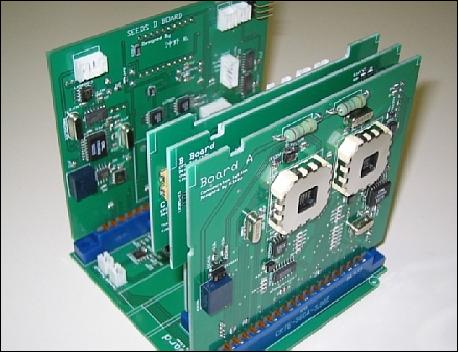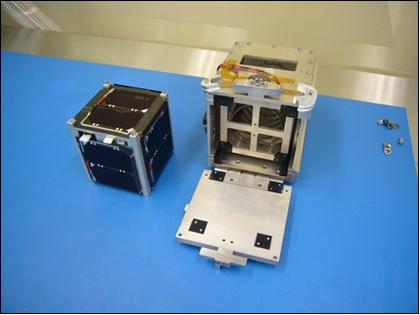SEEDS-2 (Space Engineering EDucation Satellite-2)
Non-EO
Quick facts
Overview
| Mission type | Non-EO |
| Launch date | 28 Apr 2008 |
SEEDS-2 (Space Engineering EDucation Satellite-2)
SEEDS-2 is a CubeSat mission of Nihon University, Japan. The overall objective is to demonstrate the reception of spacecraft parameter data using the CW (Continuous Wave) signal, the FM packet downlink protocol, and sound data by digitalker techniques. 1) 2) 3)
Background: SEEDS is a student-developed CubeSat program of Nihon University (Department of Aerospace Engineering, College of Science and Technology), Chiba, Japan. The project started in 2000. The development of SEEDS, the first CubeSat of Nihon University, was completed in 2004. On 26 July 2006, a launch of multiple smallsats on a Dnepr-1 launch vehicle (7th launch) from Baikonur, Kazakhstan (launch provider: ISC Kosmotras), ended in a total launch failure after about 2 minutes of flight. SEEDS was among the casualties. This launch failure represented a great setback and disappointment to all parties involved, in particular to the members of the 14 CubeSat projects. 4) SEEDS-2 replaced SEEDS.
Spacecraft
The SEEDS-2 spacecraft conforms to the CubeSat standard in size (10 cm cube) and mass (1 kg limit). The design of the spacecraft structure employs two plates and trusses (not a hexahedron box) providing adequate stiffness and strength for the launch environment. This “partial outer coverage concept” of the spacecraft enables in particular a good test, maintenance and handling environment of the subsystems. SEEDS-2 does not provide any attitude stabilization; hence, it is a free tumbling spacecraft. Spacecraft power (1.6 W) is provided by solar panels, two solar cells are surface-mounted on every side of SEEDS-2. The battery consists of four parallel Li-ion cells with a nominal voltage of 3.7 V.

The spacecraft features four microprocessors named C&DH (Command and Data Handling), FMR (Flight Management Receiver), CW (Continuous Wave), and EPS (Electric Power Subsystem). The C&DH and the FMR CPUs manage the C&DH subsystem. The C&DH CPU handles the sensors and the FM transmitter. The FMR CPU supports the FM receiver, verifies the uplink commands, and transmits the command information to each CPU.
Communications subsystem: SEEDS-2 can communicate with the ground station by using 430 MHz band (UHF, the amateur radio frequency). The onboard systems feature an FM/CW transmitter, an FM receiver, and two monopole deployable antennas. The downlink frequency is 437.485 MHz (UHF), the uplink frequency is in the VHF band. The data is transmitted based on the AX.25 protocol, the standard of amateur packet communication. The call sign is: JQ1YGU. Telemetry is to be requested by ground command (transmission mode change). 5)
When transmitting CW, the output power is 90 mW, and the FM Digitalker/SSTV (Slow Scan Television) transmitter output is around 450 mW.
The ground station for SEEDS-2 operations is located on the Funabashi campus of Nihon University located at the northern latitude of 35.725º, the longitude is 140.056944º E., the altitude is ~ 50 m above NN. The Nihon University ground station contains four phased UHF antennas for downlink and one VHF antenna for uplink, and an Icom 910D transceiver. The station, along with 12 other university stations, also participates in the Japanese Ground Station Network.
Uplink (FM Packet) | - Receiver frequency band:VHF band |
Downlink (CW Beacon) | - Transmitter frequency band: 437.485 MHz |
Downlink (FM Packet) | - Transmitter frequency band: 437.485 MHz |
Downlink (Digitalker) | - Transmitter frequency band: 437.485 MHz |
C&DH subsystem: The C&DH subsystem analyzes and executes commands received from the ground station. This subsystem receives sensor data and assembles the packets to be transmitted.
Sensor subsystem: SEEDS-2 has 3-axis geomagnetic sensors, 3-axis gyro sensors, temperature sensors, solar battery cell galvanometers, and voltage sensors. Platinum resistance temperature sensors are installed in 14 locations within the spacecraft. The sensor data is used to analyze the spacecraft's attitude as well as its overall health.


Launch
SEEDS-2 was launched on April 28, 2008 as a secondary payload to the CartoSat-2A primary spacecraft of ISRO. The launch site was SDSC (Satish Dhawan Space Centre), the SHAR launch range (Sriharikota, India) of ISRO.
The launch of secondary payloads was being shared by IMS-1 (Indian Microsatellite-1) of ISRO with the following CubeSats or nanosatellites: CanX-2 of UTIAS/SFL, Toronto, Canada; AAUSat-2 of Aalborg University, Denmark; COMPASS-1 of the University of Applied Science, Aachen, Germany; Delfi-C3 of the Technical University of Delft, The Netherlands; SEEDS of Nihon University, Japan; CUTE-1.7+APD-2 CubeSat of the Tokyo Institute of Technology; NTS (Nanosatellite for Tracking of Ships) of COM DEV / UTIAS/SFL, Toronto, Canada; Rubin-8-AIS an experimental space technology mission of OHB-System, Bremen, Germany.
The launch arrangement services of the CubeSats and nanosatellites as well as the XPOD (Experimental Push Out Deployer) systems were provided by UTIAS/SFL (University of Toronto, Institute for Aerospace Studies/Space Flight Laboratory), Toronto, Canada. XPOD is a CubeSat/nanosat deployment system developed by UTIAS/SFL.
Orbit: Sun-synchronous circular orbit, altitude = 635 km, inclination = 97.94º, local crossing time on the descending node at 9:30 hours, period = 97.20 minutes.
Mission Status
• In 2012, the SEEDS-2 mission is still operational. The project downlinks the digitalker data according to the requests by the amateur radio operators, and measures the geomagnetic field and house-keeping data (e.g., the angular velocity, battery voltage, solar cell current, temperature) to analyze the satellite status and the degradation of the solar cells and batteries. 6)
• In 2008, many people around the world received and decoded the SSTV transmissions.
• First contact (CW signal) with the SEEDS-2 spacecraft (Oscar-66) was established shortly after launch.
1) M. Yamazaki , K. Arita, Y. Araki, T. Masuda, Y. Miyazaki, K. Matsubara, Y. Nakamura, “Nihon University Nano Satellite Development Projects: SEEDS and SPROUT,” Hamamatsu, Japan, June 1-8, 2008
2) http://cubesat.aero.cst.nihon-u.ac.jp/english/main_e.html
3) http://sat.aero.cst.nihon-u.ac.jp/gs/english/seeds_detail_e.html
4) N. Kinoshita, S. Okino, K. Sase, S. Uchiyama, S. Hashiguchi, H. Nakatsuji, M. Yanagisawa, Y. Onda, Y. Iwai, K. Daigo, Y. Miyazaki, “Development of CubeSat SEEDS,” Proceedings of the 56th IAC 2005, Fukuoda, Japan, Oct. 17-21, 2005, IAC-05-B5.6.A.05
5) http://cubesat.aero.cst.nihon-u.ac.jp/english/index.html
6) Information provided by Yasuyuki Miyazaki of Nihon University, Chiba, Japan.
References
The information compiled and edited in this article was provided by Herbert J. Kramer from his documentation of: ”Observation of the Earth and Its Environment: Survey of Missions and Sensors” (Springer Verlag) as well as many other sources after the publication of the 4th edition in 2002. - Comments and corrections to this article are always welcome for further updates (eoportal@symbios.space).